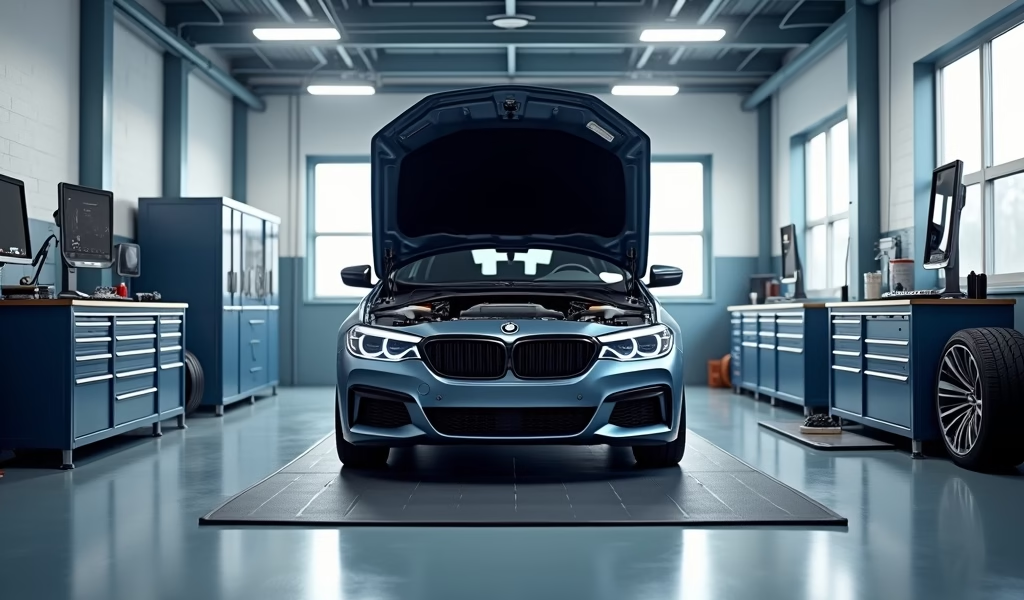Overview
This article outlines seven essential maintenance practices that significantly boost car trade-in value, including keeping detailed service records, maintaining exterior and interior condition, ensuring mechanical health, and considering pre-trade inspections. Regular maintenance can increase trade-in offers by 10-15%, with the article emphasizing that value preservation requires consistent care throughout ownership rather than last-minute preparations.
Table of Contents
- Maximizing Your Car Trade-in Value: The Maintenance Connection
- Regular Maintenance Records: Your Trade-in’s Best Friend
- Exterior Care: First Impressions Matter
- Interior Detailing: The Inside Story
- Mechanical Health: What Dealers Look For
- Tire and Wheel Condition: The Ground-Level View
- Pre-Trade Inspection: Knowledge is Power
- Conclusion
- Frequently Asked Questions
Maximizing Your Car Trade-in Value: The Maintenance Connection
Planning to trade in your vehicle? The car trade process can significantly impact your financial outcome when purchasing your next ride. As someone who’s spent over two decades working with vehicles, I can tell you that proper maintenance doesn’t just keep your car running smoothly—it directly affects your trade-in value. In fact, a well-maintained vehicle can fetch up to 10-15% more during the car trade evaluation compared to a neglected one.
The used car market has evolved dramatically over the past few years, with dealerships becoming increasingly particular about the condition of trade-ins. According to Cox Automotive’s 2023 market analysis, vehicles with comprehensive maintenance records and evident care history received substantially better offers. This means your maintenance habits aren’t just about keeping your car running—they’re a direct investment in your future financial position.
Let’s dive into seven essential maintenance practices that can maximize your car’s trade-in value. Whether you’re planning to upgrade your vehicle next month or next year, these practical tips will help ensure you get the best possible deal.
Regular Maintenance Records: Your Trade-in’s Best Friend
The single most powerful tool in your car trade arsenal isn’t a fancy detailing job or new tires—it’s documentation. Complete service records demonstrate that you’ve been a responsible owner who hasn’t cut corners on maintenance. This reassurance is gold to dealerships and can directly translate to dollars in your pocket.
Start by organizing all your maintenance receipts chronologically in a folder or digital file. Missing some records? Contact your service centers, as many keep digital histories that can be provided upon request. The most valuable records include:
- Oil change history (showing consistent intervals)
- Major service milestones (30k, 60k, 90k mile services)
- Timing belt/chain maintenance
- Transmission service documentation
- Brake service records
- Any warranty work or recall repairs
Many dealerships now use sophisticated appraisal software that factors in maintenance history when calculating trade-in values. According to Kelley Blue Book research, vehicles with complete maintenance histories typically command 5-8% higher trade-in values than identical models without documentation.
Pro tip: If you haven’t been diligent with record-keeping, start now. Even showing regular maintenance for the past year can make a positive impression during the car trade evaluation process.

Exterior Care: First Impressions Matter
When it comes to car trade negotiations, first impressions can make or break your deal. Dealerships make snap judgments about your vehicle’s overall condition based on its exterior appearance. A well-maintained exterior signals that the car has likely received proper care throughout its life.
Start with the basics: regular washing prevents contaminants like bird droppings, tree sap, and road salt from damaging your clear coat. I recommend washing your vehicle every two weeks and immediately after exposure to harsh elements. Beyond basic cleaning, consider these essential exterior maintenance practices:
- Wax your vehicle every three to four months to protect the paint and maintain its shine
- Address small chips and scratches promptly using touch-up paint to prevent rust
- Park in garages or shaded areas when possible to minimize UV damage
- Clean headlights if they’ve become foggy or yellowed (restoration kits are affordable and effective)
- Maintain windshield wipers and replace them when they begin to streak
For maximum trade-in value, consider addressing minor dents and dings. While a full body shop visit might not be cost-effective, paintless dent removal services can fix minor imperfections for a fraction of the cost. A Consumer Reports study found that addressing visible exterior damage can yield a return of up to three times the repair investment in trade-in value.
Remember, though, that excessive detailing right before trading in won’t fool experienced appraisers. They’re looking for signs of consistent care, not last-minute preparations. That’s why establishing good habits throughout your ownership is the wisest approach when preparing for a car trade.
Interior Detailing: The Inside Story
The interior condition of your vehicle tells dealers a compelling story about how you’ve treated your car overall. A clean, well-maintained cabin suggests meticulous care, while stains, odors, and excessive wear can dramatically reduce your car trade value. In my experience, interior condition can swing your trade-in offer by as much as $500-1,000 on mainstream vehicles.
Developing consistent interior maintenance habits isn’t just about preparing for trade-in—it makes your daily driving experience more pleasant, too. Here’s what I recommend to my clients:
- Vacuum thoroughly every two weeks, paying special attention to seat crevices and under floor mats
- Clean spills immediately to prevent staining (keep interior wipes in your glove compartment)
- Use appropriate cleaners for different surfaces—leather, vinyl, and fabric each require specific care
- Protect dashboard and interior plastic from UV damage with appropriate protectants
- Address unpleasant odors naturally rather than masking them with air fresheners
For those planning a car trade in the next few months, consider a professional interior detailing service. The $150-250 investment can yield significant returns by addressing issues you might miss. Professional detailers can remove stubborn stains, condition leather, clean air vents, and eliminate odors that you may have become “nose blind” to over time.
One often overlooked aspect of interior maintenance is the functionality of all controls and features. Make sure all power windows, locks, seat adjustments, infotainment systems, and climate controls work properly. Small electronic issues can raise red flags during dealer inspections, suggesting potential underlying problems that might affect your car buying negotiation position.
Mechanical Health: What Dealers Look For
When evaluating your vehicle for trade-in, dealerships aren’t just looking at cosmetic condition—they’re assessing mechanical health to determine potential reconditioning costs. Having spent years on both sides of car trade transactions, I can tell you that mechanical issues will be discovered during the appraisal process, no matter how well-hidden they might seem.
The most scrutinized mechanical components during trade-in evaluations include:
- Engine performance (including unusual noises, smoke, or leaks)
- Transmission operation (smooth shifting, proper engagement)
- Brake system condition (pad thickness, rotor condition, pedal feel)
- Suspension components (struts, shocks, bushings)
- Electrical system functionality (battery health, alternator output)
Regular maintenance of these systems doesn’t just maintain trade-in value—it prevents catastrophic failures that could leave you stranded. Following your manufacturer’s recommended service intervals is the most cost-effective approach to preserving mechanical health.
For those approaching major service intervals (typically 60,000, 90,000, or 120,000 miles), consider whether completing these services before trade-in makes financial sense. While a 60,000-mile service might cost $500-800, skipping it could reduce your trade value by $1,000-1,500 if the dealer must factor this pending maintenance into their reconditioning costs.
One particularly important area to address is check engine lights or warning indicators. These red flags instantly reduce trade-in offers, even if the underlying issue is minor. Before heading to the dealership, have diagnostic codes checked and address any warning lights. The experts at Edmunds note that resolving check engine lights before appraisal typically yields a return of 2-3 times the repair cost in preserved trade value.

Tire and Wheel Condition: The Ground-Level View
Tires and wheels might seem like minor details in the car trade process, but they can significantly impact your vehicle’s perceived value. As a certified mechanic who’s handled countless trade-in appraisals, I’ve seen tire condition alone adjust offers by $300-600 depending on the vehicle segment.
Dealers examine several aspects of your tires during appraisal:
- Tread depth (using a gauge to measure remaining life)
- Wear pattern (indicating alignment issues or improper inflation)
- Brand and quality (premium vs. budget tires)
- Age (checking date codes for deterioration)
- Matching set (mismatched tires suggest neglect)
Maintaining proper tire inflation not only preserves tread life but also improves fuel economy and safety. I recommend checking pressure monthly and before long trips. Your vehicle’s recommended tire pressure is typically found on a sticker inside the driver’s door jamb—not the maximum PSI listed on the tire sidewall.
For those preparing for a car trade, consider your tire situation carefully. If your tires have less than 4/32″ of tread remaining, dealers will factor replacement costs into their offer. However, installing brand new tires before trading rarely provides a full return on investment. Instead, focus on maintaining what you have through regular rotation, balancing, and alignment.
Wheel condition matters too. Curb rash, bent rims, or missing center caps suggest careless driving habits. Minor curb damage can often be repaired at wheel refinishing shops for $75-150 per wheel—potentially worth the investment if your vehicle falls into a higher-value category.
Remember that season-appropriate tires matter when trading in. If you’re trading during winter with summer performance tires mounted (or vice versa), dealers may deduct for the need to switch to season-appropriate rubber before resale. This is especially relevant when buying a used car in regions with distinct seasonal weather patterns.
Pre-Trade Inspection: Knowledge is Power
Before heading to the dealership for a car trade evaluation, consider investing in a pre-trade inspection. This proactive step gives you valuable information about your vehicle’s condition from an objective source, empowering you during negotiations. As someone who’s worked with trade-ins for years, I can tell you that dealers respect prepared customers.
A pre-trade inspection typically costs $100-200 and provides:
- Documentation of your vehicle’s current condition
- Identification of issues that might affect valuation
- Opportunity to address minor problems before appraisal
- Professional assessment of your vehicle’s market position
- Confidence during the negotiation process
Many repair shops and independent mechanics offer pre-purchase inspections that serve perfectly as pre-trade assessments. These comprehensive evaluations examine mechanical condition, fluid levels, electronic systems, and body condition. Some even include computer diagnostics to identify potential issues not yet triggering warning lights.
Armed with this information, you can make strategic decisions about which issues to fix before trading. The mechanic’s report also serves as third-party validation of your vehicle’s condition, potentially neutralizing a dealer’s claims about necessary repairs during negotiation.
Another benefit of pre-trade inspections is discovering your vehicle’s genuine market position. Mechanics familiar with local markets can provide insights about how your specific make, model, and condition compare to others they’ve recently seen. This contextual information helps set realistic expectations and prevents disappointment during the car trade process.
Remember, knowledge is negotiating power. When a dealer sees that you’ve done your homework with a pre-trade inspection, they’re more likely to present their best offer upfront rather than starting with a lowball figure.
Conclusion
Maximizing your car trade-in value isn’t about last-minute fixes or clever negotiation tactics—it’s about developing consistent maintenance habits throughout your ownership period. The seven essential maintenance areas we’ve covered create a comprehensive approach to preserving your vehicle’s value while ensuring reliable, safe transportation during your ownership.
From keeping detailed maintenance records to ensuring mechanical health, each aspect contributes significantly to how dealerships perceive your vehicle’s worth. Remember that dealers aren’t just buying your car—they’re purchasing the story of how well it’s been cared for, and that story is told through documentation, appearance, and mechanical condition.
The most successful car trade experiences come from treating maintenance as an ongoing investment rather than a pre-trade scramble. By integrating these seven maintenance practices into your regular vehicle care routine, you’re not just preparing for an eventual trade-in—you’re enjoying a more reliable, comfortable, and economical driving experience every day.
When the time comes to part with your vehicle, you’ll approach the dealership with confidence, armed with documentation and knowledge about your car’s true condition. That confidence translates directly into negotiating power and, ultimately, more money in your pocket for your next automotive adventure.
Frequently Asked Questions
How much can regular maintenance really improve my car’s trade-in value?
Consistent maintenance typically increases trade-in offers by 10-15% compared to poorly maintained vehicles. This percentage increases for luxury or high-performance vehicles where maintenance history is even more critical.
Should I fix minor mechanical issues before trading in my car?
Fix issues that cost less than the potential reduction in trade value they would cause. Check engine lights, brake problems, and fluid leaks almost always warrant repair before trade-in.
How important is detailing my car before a trade-in appraisal?
Very important—a professional-level cleaning can improve perceived value by $200-500. Focus on removing stains, odors, and ensuring all interior surfaces are clean and conditioned.
Do aftermarket modifications help or hurt trade-in value?
Most modifications decrease trade-in value as dealers prefer stock vehicles. Tasteful upgrades like premium wheels might be exceptions, but expect to recover only a fraction of your investment.
What’s the best time to trade in my car for maximum value?
Trade before reaching major maintenance milestones (60k, 90k, 120k miles) to avoid expensive services. Seasonally, convertibles command better values in spring, while AWD vehicles peak in fall/winter months in northern regions.

